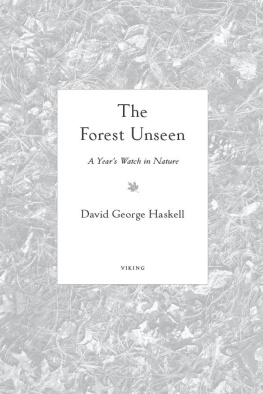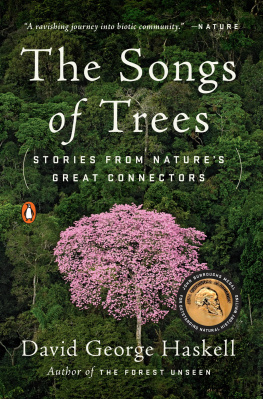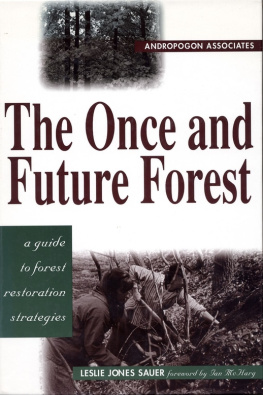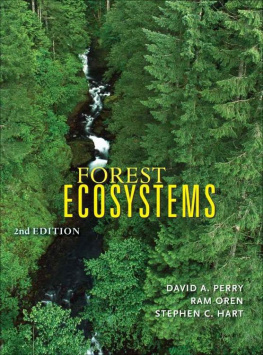The
Forest Unseen
The
Forest Unseen
A Years Watch in Nature

David George Haskell
VIKING
VIKING
Published by the Penguin Group
Penguin Group (USA) Inc., 375 Hudson Street, New York, New York 10014, U.S.A.
Penguin Group (Canada), 90 Eglinton Avenue East, Suite 700, Toronto, Ontario, Canada M4P 2Y3 (a division of Pearson Penguin Canada Inc.)
Penguin Books Ltd, 80 Strand, London WC2R 0RL, England
Penguin Ireland, 25 St. Stephens Green, Dublin 2, Ireland (a division of Penguin Books Ltd)
Penguin Books Australia Ltd, 250 Camberwell Road, Camberwell, Victoria 3124, Australia (a division of Pearson Australia Group Pty Ltd)
Penguin Books India Pvt Ltd, 11 Community Centre, Panchsheel Park, New Delhi - 110 017, India
Penguin Group (NZ), 67 Apollo Drive, Rosedale, Auckland 0632, New Zealand (a division of Pearson New Zealand Ltd) Penguin Books (South Africa) (Pty) Ltd, 24 Sturdee Avenue, Rosebank,
Johannesburg 2196, South Africa
Penguin Books Ltd, Registered Offices: 80 Strand, London WC2R 0RL, England
First published in 2012 by Viking Penguin, a member of Penguin Group (USA) Inc.
1 3 5 7 9 10 8 6 4 2
Copyright David George Haskell, 2012
All rights reserved
LIBRARY OF CONGRESS CATALOGING IN PUBLICATION DATA
Haskell, David George.
The forest unseen : a years watch in nature / David George Haskell.
p. cm.
Includes bibliographical references and index.
EISBN: 9781101561065
1. Old growth forest ecologyTennessee. 2. Old growth forestsTennessee. 3. Natural historyTennessee. 4. SeasonsTennessee. 5. Nature observationTennessee. 6. Haskell, David George. 7. Philosophy of nature. I. Title.
QH105.T2H37 2012
577.309768dc23 2011037552
Printed in the United States of America
Designed by Nancy Resnick
No part of this book may be reproduced, scanned, or distributed in any printed or electronic form without permission. Please do not participate in or encourage piracy of copyrighted materials in violation of the authors rights. Purchase only authorized editions.
For Sarah
Contents
Preface
Two Tibetan monks lean over a table, cradling brass funnels in their hands. Colored sand spills from the tips of the funnels onto the table. Each fine stream adds another line to the growing mandala. The monks work from the center of the circular pattern, following chalk lines that define the fundamental shapes, then filling in hundreds of details from memory.
A lotus flower, symbol of Buddha, lies at the center and is enclosed by an ornate palace. The four gates of the palace open out to concentric rings of symbols and color, representing steps on the path to enlightenment. The mandala will take several days to complete, then it will be swept up and its jumbled sands cast into running water. The mandala has significance at many levels: the concentration required for its creation, the balance between complexity and coherence, the symbols embedded in its design, and its impermanence. None of these qualities, however, define the ultimate purpose of the mandalas construction. The mandala is a re-creation of the path of life, the cosmos, and the enlightenment of Buddha. The whole universe is seen through this small circle of sand.
A group of North American undergraduates jostle behind a rope nearby, extending their necks like herons as they watch the mandalas birth. They are uncharacteristically quiet, perhaps caught up in the work or stilled by the otherness of the monks lives. The students are visiting the mandala at the beginning of their first laboratory class in ecology. The class will continue in a nearby forest, where the students will create their own mandala by throwing a hoop onto the ground. They will study their circle of land for the rest of the afternoon, observing the workings of the forest community. One translation of the Sanskrit mandala is community, so the monks and the students are engaged in the same work: contemplating a mandala and refining their minds. The parallel runs deeper than this congruence of language and symbolism. I believe that the forests ecological stories are all present in a mandala-sized area. Indeed, the truth of the forest may be more clearly and vividly revealed by the contemplation of a small area than it could be by donning ten-league boots, covering a continent but uncovering little.
The search for the universal within the infinitesimally small is a quiet theme playing through most cultures. The Tibetan mandala is our guiding metaphor, but we also find context for this work in Western culture. Blakes poem Auguries of Innocence raises the stakes by shrinking the mandala to a speck of earth or a flower: To see a World in a Grain of Sand / And a Heaven in a Wild Flower. Blakes desire builds on the tradition of Western mysticism most notably demonstrated by the Christian contemplatives. For Saint John of the Cross, Saint Francis of Assisi, or Lady Julian of Norwich, a dungeon, a cave, or a tiny hazelnut could all serve as lenses through which to experience the ultimate reality.
This book is a biologists response to the challenge of the Tibetan mandala, of Blakes poems, of Lady Julians hazelnut. Can the whole forest be seen through a small contemplative window of leaves, rocks, and water? I have tried to find the answer to this question, or the start of an answer, in a mandala made of old-growth forest in the hills of Tennessee. The forest mandala is a circle a little over a meter across, the same size as the mandala that was created and swept away by the monks. I chose the mandalas location by walking haphazardly through the forest and stopping when I found a suitable rock on which to sit. The area in front of the rock became the mandala, a place that I had never seen before, its promise mostly hidden by winters austere garb.
The mandala sits on a forested slope in southeastern Tennessee. One hundred meters upslope, a high sandstone bluff marks the western edge of the Cumberland Plateau. The ground falls away from this bluff in steps, alternating level benches with sharp inclines, descending one thousand feet in elevation to the valley floor. The mandala nestles between boulders on the highest bench. The slope is entirely forested with a diverse collection of mature deciduous trees: oaks, maples, basswoods, hickories, tuliptrees, and a dozen more species. The forest floor is ankle-twistingly strewn with jumbled rock from the eroding bluff, and in many places there is no even ground, just heaved, fissured stone overlain with leaf mulch.
The steep, challenging terrain has protected the forest. At the bottom of the mountain, the fertile, level soil on the valley floor is relatively free of rocky encumbrances and has been cleared for pasture and crops, first by Native Americans, then by settlers from the Old World. A few homesteaders tried to farm the mountainside in the late nineteenth and early twentieth centuries, a task that was as hard as it was unproductive. Moonshine stills gave these subsistence farmers extra income, and this mountainside got its name, Shakerag Hollow, from the way townspeople would summon the distillers by waving a rag that was then left with some money. A jar of strong liquor would take the place of the money some hours later. The forest has now reclaimed the small agricultural openings and still sites, although the locations of the old clearings are marked by rock heaps, old pipes, rusted washtubs, and daffodil patches. Much of the rest of the forest was logged for lumber and fuel, especially at the turn of the twentieth century. A few small pockets of forest were left untouched, shielded by inaccessibility, luck, or the whims of landowners. The mandala sits in one such patch, a dozen or so acres of old-growth forest embedded in thousands of acres of forest that, although it has been cut in the past, is now mature enough to sustain much of the rich ecology and biological diversity that characterize Tennessees mountain forests.
Next page








![Will Kurt [Will Kurt] - Get Programming with Haskell](/uploads/posts/book/116897/thumbs/will-kurt-will-kurt-get-programming-with-haskell.jpg)



